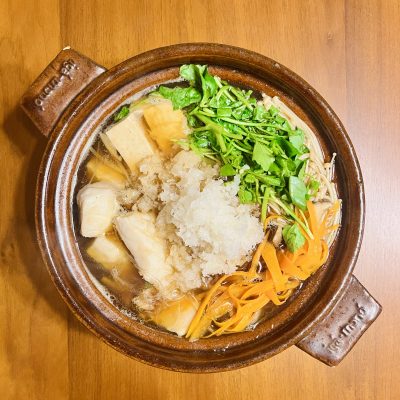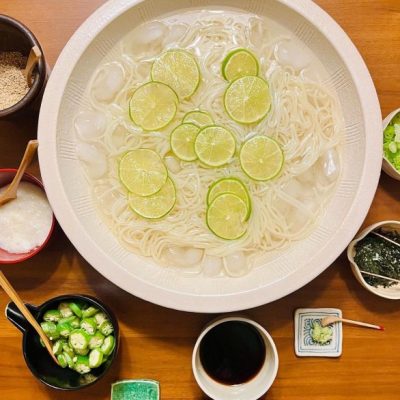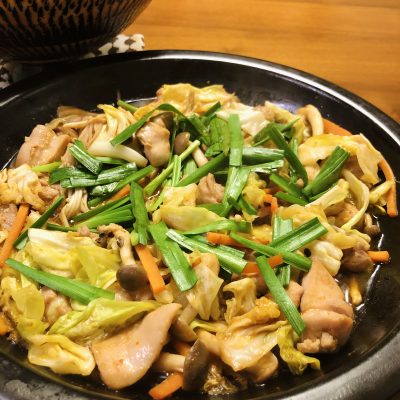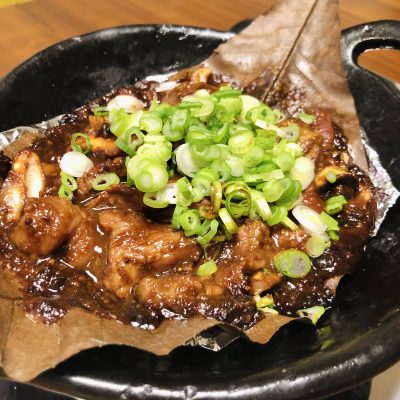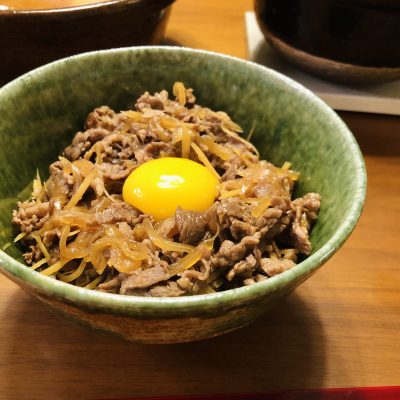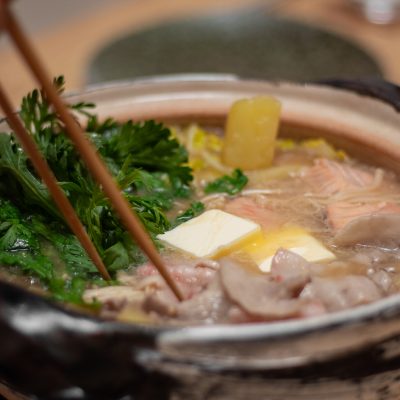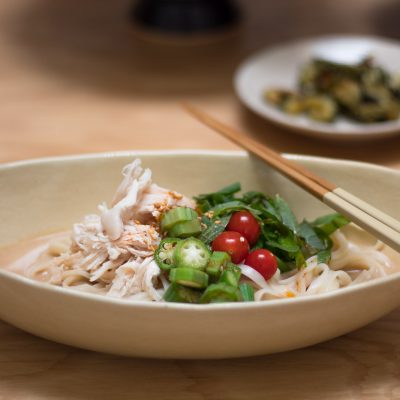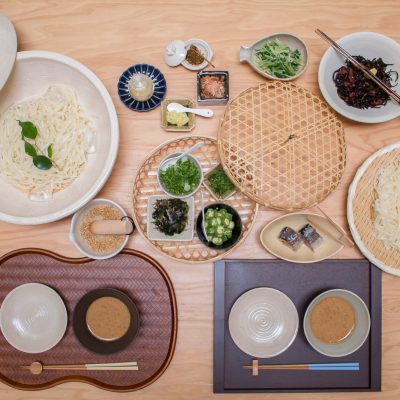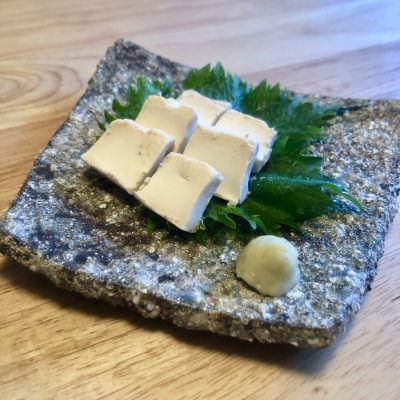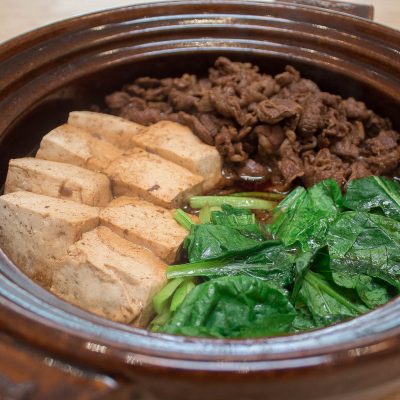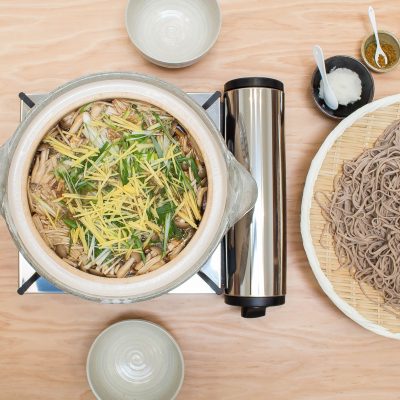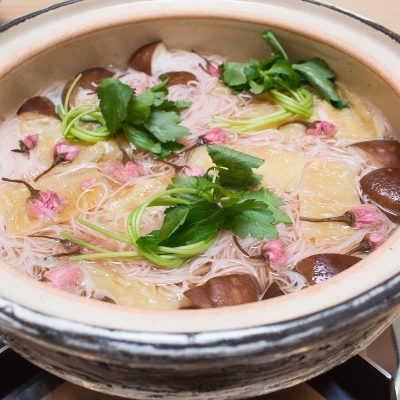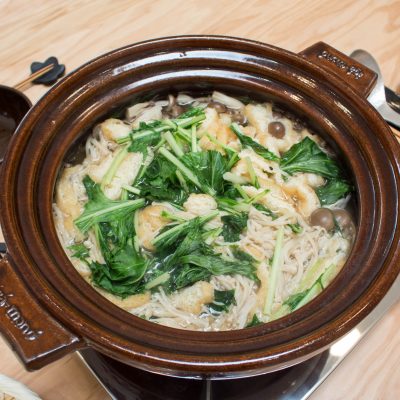Here’s my healthy seafood hot pot, Halibut Mizore Nabe – Halibut (or your choice of fish) is quickly simmered with vegetables and finished with a generous amount of grated daikon on top. With the addition of the glass noodles, this dish makes a very satisfying one pot donabe meal.
Tag Archives: Mirin
Cold Somen Noodle with Soy Dipping Sauce
Perfect for a hot summer day. Here’s one of my most basic cold noodle dishes which I never get tired of all my life. Donabe can make a perfect serving vessel, and it also makes a wonderful presentation, along with a variety of toppings.
For the dipping sauce, I have this staple soy-based sauce, Kaeshi, always in handy. Kaeshi is a multi-purpose sauce I use for so many things. I pour over noodle by mixing with water/ dashi, chicken, fish, salad, etc.
Sizzling Shoyu Chicken & Cabbage
Kei-chan is a very popular local dish from Gifu, Japan. In my past visits to Gifu, I was really fascinated by this homy chicken dish. The main ingredients are chicken and cabbage, and they are sit-fried together in either miso or soy-based sauce. I especially love the soy-based version, so I now have my own version and it’s so good. Because it’s stir-fried, tagine-style donabe works especially great with its flat skillet bottom. But, you can also improvise the dish with other types of donabe which can be heated empty.
Toban Beef with Miso Sauce
Hoba Miso is a traditional dish, originate in Hida region of Gifu, Japan. This mountainous region is situated in the northern end of Gifu and has a long snowy winter. So, many preserved foods, including miso, pickles, koya tofu (freeze-dry tofu) etc., were developed there. Hoba Miso is one of their traditional dishes and it’s basically a miso-based sauce, cooked on a dry magnolia leaf. One of the most popular toppings for this dish is beef, as Gifu is famous for its premium Hida Beef, and it’s one of my favorite dishes from Gifu! Here in LA, I enjoy making this dish cooked in Toban (donabe skillet) with local beef. Every time I make this dish, it makes me want to visit Gifu again. Hoba (magnolia) leaf is not readily available in the US, so you can be creative with a different leaf (like a banana leaf?) or simply place a parchment paper on a Toban to cook it.
Beef Bowl
Gyu-Don, or beef bowl, is one of the most popular rice bowl dishes in Japan. It’s basically soy-flavored and slightly sweet simmered thin beef slices over rice. Here in LA where I live now, unless I take a trip to a Japanese market, I can’t get very thinly sliced beef at a regular market like in Japan. So, I usually get a block of boneless beef short rib and hand-slice it very thinly myself. I actually find this hand-cut version better than the other. The meat is simmered with onion in donabe for about half an hour and the result is such tender and flavorful beef. Donabe can bring out all the umami flavors cooked in it and become quite magical.
Miso Butter Hot Pot with Salmon and Pork
I’ve made this hot pot many times this season, both for myself and many other people. And, many of them asked me to share the recipe so they can make it home. The miso broth has two kinds of miso for complexity. The addition of butter at the end gives the beautiful depth in flavor.
Ishikari Nabe is originally a regional dish from Hokkaido (the northern island of Japan), and to me, the must “rule” to be called Ishikari Nabe is that the dish has to have salmon and potato in the miso broth. They taste so good together (especially with the butter added at the end)! That being said, the broth can go well with just about anything, so you can change around the ingredients to cook in it. When I cook for my vegan friends, I use kombu and shiitake dashi, and make it with tofu and different kinds of mushrooms (and no butter).
You can make the miso base (mixture of the miso, sake, mirin and soy sauce) in advance, and when it’s ready to serve, you can simply combine the miso base with dashi, and start cooking the ingredients in it at the table (or at in the kitchen stove and serve at the table).
For “shime” (finishing course), I love making ojiya (soupy porridge) in the remaining broth. Ramen is also great, too.
Salmon Roe & Grated Daikon Cold Udon
Here is another cold noodle dish with the classic topping combination of salmon roe and grated daikon (“ikura oroshi” – the other dish I posted with the combo is with cold soba and you can find a link here). This is served over udon and the broth is rich in dashi with a refreshing accent with yuzu juice and rice vinegar. The broth is so soothing, so you can drink it up, too.
You can make your own variations with different toppings such as chicken tender, roasted vegetables, wakame, eggs, or anything you like. I also like it with grilled eggplant!
Cold Udon with Sesame Soymilk Sauce
This cold udon dish has a very tasty and refreshing broth made of soymilk and golden sesame paste. It’s poured over the udon and really makes the dish so special. For this broth, I use my Dashi Shoyu (rich dashi-flavored soy sauce) as a base seasoning. This Dashi Shoyu is extremely versatile and can be used it on its own as a seasoning for sautéed dish or can be mixed other liquid (can be just water) to make a broth or a sauce. So, I keep my Dashi Shoyu in my fridge always. Once you make a batch of it, you can keep it for up to a month or even longer.
The toppings can be basically anything you like, so you can be creative.
Cold Udon with Golden Sesame Dipping Sauce
I love cold udon as much as cold somen especially in the summertime. It would depend on the type of udon, but cold udon usually has the nice bouncy texture and it’s also smooth when it goes through the throat. Serving cold udon in a donabe with some ice cubes not only makes a beautiful presentation, but with the porous donabe body gets insulated, it can keep the noodle very cold for extended time.
For this dish, I served the same rich sesame sauce which I introduced in the cold somen recipe. This is a versatile sauce and has nice nutty flavor with natural sweetness coming from the combination of the Golden Sesame Paste and Saikyo Miso.
Enjoy with your choice of toppings. I also like it with canned saba (Japanese mackerel). I usually bring back a very nice kind from Japan.
Miso-Marinated Cream Cheese
Super easy to make with just a few ingredients, with just a little bit of patience, this dish makes a great snack/ appetizer to easily please your guests. All you need to do is to marinade a block of cream cheese in miso+mirin mixture for a few days or longer. This is also a perfect dish to keep stock in your fridge, so you can just slice and serve when you want to quickly entertain your guest or when you need one more little dish. You can enjoy the slices with a little wasabi on the side to enjoy with your sake. Or, this can make wonderful canapés to serve on crackers at a party. And, that’s what we did at a event at TOIRO the other day…it was a big hit!
Tamari-Flavored Beef and Tofu Stew
Simple, quick, and satisfying, beef and tofu stew is a popular home dish in Japan. With an addition of komatsuna (Japanese spinach – you can substitute with regular spinach or other leafy greens), it makes a nutritiously balanced one-pot dish. I love using Tamari Soy Sauce for seasoning, as it gives a nice deep flavor, but you can also make it with regular soy sauce and it will still taste great. If you have any leftovers, I highly suggest you reheat it in a donabe (or a small pot), drizzle some whisked egg over it, then once the egg is at your desired consistency, pour the whole thing over the rice to make a beef and tofu rice bowl. Just so that I will have enough leftover the next day, I tend to make extra amounts of this dish.
Soba Noodle with Hot Mushroom Dipping Broth
I love making this dish especially when I am feeling a little weak and need something gentle for my stomach. Once you simmer mushrooms in a rich dashi-based broth, pour it into serving bowls and dip cold noodles in it to enjoy. The mushrooms adds the nice savory flavors to the broth. And, I love to use a generous amount of thinly-sliced ginger for both flavor and helping my body stay warm after having the dish. It’s so soothing and you can keep eating more and more. This dish is also nice to serve for a larger group. You can also change around the ingredients to cook in the broth for fun. For a vegan version, you can make with kombu dashi or vegetable dashi instead of kombu & bonito dashi.
Somen Noodle and Cherry Blossoms Hot Pot
I always get so excited when the spring season comes and make a lot of cherry blossom-theme dishes. This is one of them and I add salt-preserved sakura (cherry blossom) flowers to the broth, and I even use the pink sakura-flavored somennoodles made from flour and sakura from Japan. The aroma of sakura in this dish is just so beautiful. But, don’t worry if you don’t have any of them! You can totally make the delicious somen hot pot without the sakura flavors, and this dish can be enjoyed all year round. You can also change the other ingredients to cook with the noodles by using different kinds of mushrooms or tofu, if you like. It’s so gentle on the stomach and always comforting.
Dashi-Rich Steam-Fry Hiramasa and Napa Cabbage
Simply assembled hiramasa (amberjack) with napa cabbage and shimeji mushrooms taste so pure and satisfying with the rich flavor of the dashi broth. The broth’s umami level is boosted with the addition of ayu fish sauce (I call this “magic essence”). Hiramasa can be substituted with yellowtail, sea bass, snapper, salmon, or any buttery fish filet. I like to serve this dish with plain donabe rice (white or brown).
Chirashi Sushi with Soy-Marinated Tuna
This dish is very easy to make and always a crowd pleaser. Once you get a block of very fresh tuna, all you have to do is to make sushi rice, slice and marinade tuna, get other small components ready and just assemble. The marinating time of tuna should be just up to 15 – 20 minutes. If it’s marinated too long, it will start to “cook” the tuna and the color could get a bit too dark. I like to make the sushi rice by adding 16 Multi Mixed Grains for more complex flavor, texture, and beautiful color in the sushi rice, but you can make it without, too. Whenever I make this dish for friends, it disappears in a matter of moments!
Mushroom & Mizuna Hot Pot
This simple vegan hot pot is so rich in flavor and satisfying. I like to slice the abura-age very thin, as these slices soak up the broth and taste like juicy noodles. If you don’t have access to abura-age, thinly-sliced tofu can work, too. The key for the rich broth flavor is to add the mushrooms before heating up the kombu-soaked water, so the mushrooms release all the umami flavors during the slow heating process. For the shime (finishing course), I like to add udon noodles to the remaining broth, but soba is also good, too.

